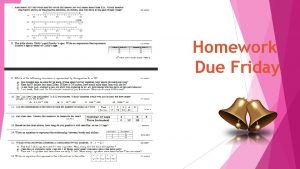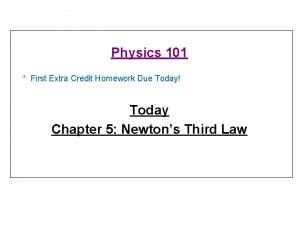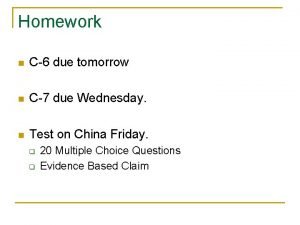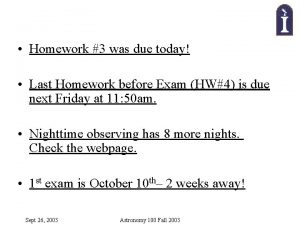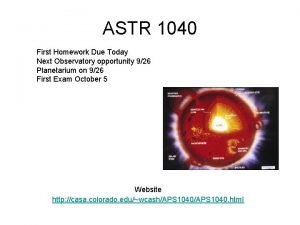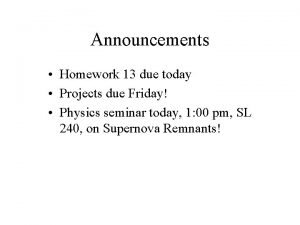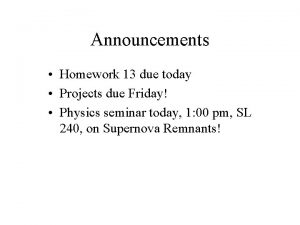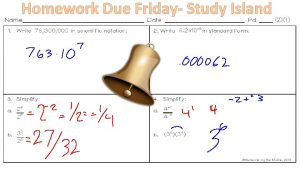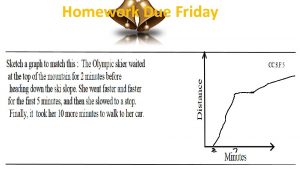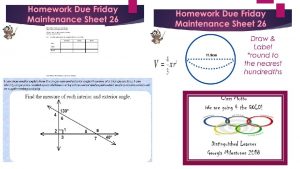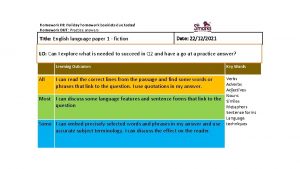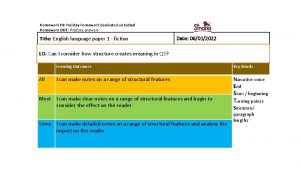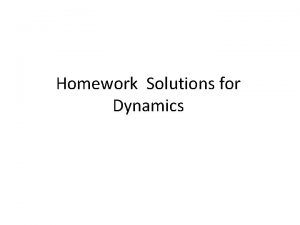Announcements Homework 2 Solutions online Homework 3 Due










![Warmup How many surjections are there [n] → [3]? There are 3 n total Warmup How many surjections are there [n] → [3]? There are 3 n total](https://slidetodoc.com/presentation_image_h2/98d576334f5ce73433e5c9cff61ec0a4/image-11.jpg)
![Missing 1 How many functions [n] → [3] don’t have 1 in their image? Missing 1 How many functions [n] → [3] don’t have 1 in their image?](https://slidetodoc.com/presentation_image_h2/98d576334f5ce73433e5c9cff61ec0a4/image-12.jpg)




![General Version S(n, k) = number of partitions of [n] into k parts. If General Version S(n, k) = number of partitions of [n] into k parts. If](https://slidetodoc.com/presentation_image_h2/98d576334f5ce73433e5c9cff61ec0a4/image-17.jpg)


![Counting How many functions are there from [n] to [k]-{i 1, i 2, …, Counting How many functions are there from [n] to [k]-{i 1, i 2, …,](https://slidetodoc.com/presentation_image_h2/98d576334f5ce73433e5c9cff61ec0a4/image-20.jpg)



- Slides: 23

Announcements • Homework 2 Solutions online • Homework 3 Due on Friday

Last Time • Inclusion-Exclusion

Inclusion-Exclusion Theorem: Given any sets S 1, S 2, …, Sn we have that:

Today • Alternative Proof of I-E • Applications – Formula for Sterling Numbers – Counting Derangements

Alternative Proof • Start by considering just |S 1|+|S 2|+…+|Sn|. • Counts each element of each set. – Problem: Counts elements in multiple sets more than once. • Want to subtract back off this extra. • Subtract |S 1∩S 2|+ |S 1∩S 3|+…+|Sn-1∩Sn| – This compensates for overcounting elements in exactly 2 sets. – But undercounts elements in more than 2 sets. • Need to add on intersections of 3 and subtract off intersections of 4 and so on.

Alternative Proof (Continued) So if an element x is in exactly m of the Si’s, how much does it contribute to the final sum? • In m of the individual sets. • In m. C 2 of the pairwise intersections (take any 2 of the sets that x is in). • In m. C 3 of the 3 -wise intersections. • …

Total Contribution The total contribution of x is: Lemma: For any integer m ≥ 1, So, any x is counted exactly once.

Proof of Lemma • If S is a set of size m, m. Ck is the number of subsets of size k. • The above equals the number of subsets of S of even size minus the number of subsets of odd size. Claim: Any non-empty set S has as many subsets of even size as odd size.

Proof of Claim We find a bijection between the sets of even size and the sets of odd size: • Choose some x ∈ S. • Pair up subsets T, T∪{x}. • Each pair has one set of even size and one set of odd size. • Each subset in exactly one pair.

Application: Sterling Numbers Recall: The number of ways to put n labeled balls into k labeled, non-empty boxes is k!S(n, k). [First pick the set partition, then pick which part goes into which box. ] This is the same as the number of surjections from a set of size [n] to a set of size [k]. If we can count this, we can compute Sterling numbers!
![Warmup How many surjections are there n 3 There are 3 n total Warmup How many surjections are there [n] → [3]? There are 3 n total](https://slidetodoc.com/presentation_image_h2/98d576334f5ce73433e5c9cff61ec0a4/image-11.jpg)
Warmup How many surjections are there [n] → [3]? There are 3 n total functions, but not all are surjections. Which ones are we missing? • Functions that don’t have 1 in their range. • Functions that don’t have 2 in their range. • Functions that don’t have 3 in their range.
![Missing 1 How many functions n 3 dont have 1 in their image Missing 1 How many functions [n] → [3] don’t have 1 in their image?](https://slidetodoc.com/presentation_image_h2/98d576334f5ce73433e5c9cff61ec0a4/image-12.jpg)
Missing 1 How many functions [n] → [3] don’t have 1 in their image? • These are functions [n] → {2, 3}. – n values, each has 2 options. – Total of 2 n such functions. • Similar results for functions missing 2 and missing 3.

Combining • So we have 3 n total functions. • Subtract 2 n that are missing 1, 2 n missing 2 and 2 n missing 3. • Are we done? – No! These removed sets overlap. Need to use Inclusion-Exclusion.

Setup Let A 1 = {functions missing 1} A 2 = {functions missing 2} A 3 = {functions missing 3} Want 3 n - |A 1∪A 2∪A 3|. Use Inclusion-Exclusion. 3 n-|A 1|-|A 2|-|A 3|+|A 1∩A 2|+|A 1∩A 3| +|A 2∩A 3|-|A 1∩A 2∩A 3|.

Intersections What is |A 1∩A 2|? • Functions taking value neither 1 nor 2. – Only the function assigning 3 to everything. • Similar for other pairwise intersections. What about |A 1∩A 2∩A 3|? • Functions not taking values 1, 2 or 3. • None of them.

Answer Final answer: 3 n-2 n-2 n-2 n+1+1+1 -0 = 3 n-3· 2 n+3. Therefore, S(n, 3) = 3 n-1/2+2 n-1+1/2.
![General Version Sn k number of partitions of n into k parts If General Version S(n, k) = number of partitions of [n] into k parts. If](https://slidetodoc.com/presentation_image_h2/98d576334f5ce73433e5c9cff61ec0a4/image-17.jpg)
General Version S(n, k) = number of partitions of [n] into k parts. If we label the parts 1, 2, …, k (can be done in k! ways), we get a surjection [n] → [k]. So: #{Surjections [n] → [k]} = k! S(n, k). How many surjections are there?

Setup Counting all functions is easy. A function fails to be a surjection if and only if some value fails to be in the image. Let S be the set of all functions [n] → [k]. Let Ai be the set of functions [n] → [k] with i not in the image. #{Surjections} = |S| - |A 1∪A 2∪A 3∪…∪Ak|

Inclusion-Exclusion |S| = kn. How big is |Ai 1∩Ai 2∩…∩Aim|? Ai 1∩Ai 2∩…∩Aim = {Functions [n] → [k] with none of i 1, i 2, …, im in the image} = {Functions [n] → [k] – {i 1, i 2, …, im}}.
![Counting How many functions are there from n to ki 1 i 2 Counting How many functions are there from [n] to [k]-{i 1, i 2, …,](https://slidetodoc.com/presentation_image_h2/98d576334f5ce73433e5c9cff61ec0a4/image-20.jpg)
Counting How many functions are there from [n] to [k]-{i 1, i 2, …, im}? Each of the n elements has k-m options for the image. These are independent so (k-m)n.

Algebra How many terms in the inner sum? • One for every set of m indices from [k]. • Total of k. Cm.

Putting it Together Rearranging, we find:

Derangements Definition: A derangement is a permutation with no 1 -cycles. Dn = #{Derangements of [n]}. For example, if n people at a party each have a hat, and each person take a random hat when they leave, the probability that nobody leaves with their own hat is Dn/n!.
 Pvu announcements
Pvu announcements /r/announcements
/r/announcements Church announcements
Church announcements What happened when montag crossed the ten-lane highway?
What happened when montag crossed the ten-lane highway? Potentiial
Potentiial General announcements
General announcements Ha quattro angoli retti
Ha quattro angoli retti Procedural vs substantive due process
Procedural vs substantive due process Slidetodoc. com
Slidetodoc. com Principio di conservazione della quantità di moto
Principio di conservazione della quantità di moto Homework due today
Homework due today Homework is due on friday
Homework is due on friday Homework is due on friday
Homework is due on friday Black cat analogy
Black cat analogy Homework due today
Homework due today Ilegalism
Ilegalism Homework
Homework Homework is due
Homework is due 3 weeks from today
3 weeks from today Homework due today
Homework due today Homework due today
Homework due today Jack prelutsky homework oh homework
Jack prelutsky homework oh homework Homework oh homework i hate you you stink
Homework oh homework i hate you you stink Jack prelutsky homework oh homework
Jack prelutsky homework oh homework












